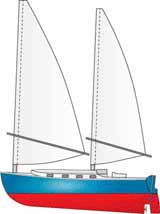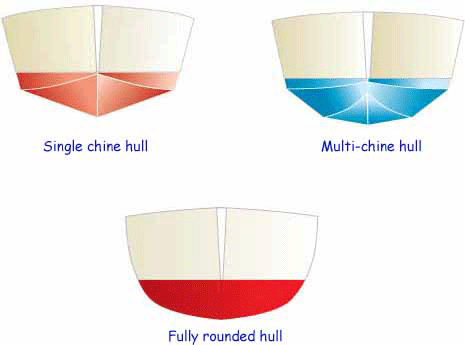- Home
- Nautical Terms and Phrases
- Boating Terms
The A-Z of Boating Terms and Other Nautical Jargon
Are you confused by boating terms? Do they leave you 'all at sea'?
Can’t tell your boom from your bumkin or your tumblehome from your baggywrinkle?
This glossary sets out to shed light your darkness...
More Pages of Boating Terms...
Bridle to Clevis Pin... (this page)
Mercator Projection to Pooped...
Sailmaker's Palm to Spreader... (this page)
Bridle to Clevis Pin...
Bridle ~ Two lines attached to the end of a drogue line or anchor rode and taken to separate cleats aboard, the intention being to share the load in extreme conditions.
Brig ~ A two-masted square-rigged sailing vessel
Brightwork ~ Varnished wood surface above decks. Something to be minimised or best avoided altogether.
Broach ~ When a boat running downwind slews brodaside to the wind and heels dangerously it is said to have broached. It's usually caused by heavy following seas or a helmsman's error - particularly when flying a spinnaker.
Broad Reach ~ A point of sail where the wind is from aft of the beam bur not directly (or nearly) astern.
Bulkhead ~ A structural lateral (athwartship) partition inside a hull.
Bulb Keel ~ A type of keel with a lead or iron torpedo-like bulb at its base for increased righting moment.
Bulwark ~ The extension of the hull above the outer edge of the deck. Often replaced by an alloy toerail on modern boats.
Burgee ~ A small flag or pennant flown from the masthead or port crosstree.
By the Lee ~ When sailing down wind with wind blowing from the side on which the boom is lying, you’re sailing ‘by the lee’ – which can be dangerous.
C...
Cable ~ (1) A rope or chain attached to the anchor. Or (2) one-tenth of a nautical mile.
Camber ~ A boating term that refers to the upward curve of a deck on a boat.
Capsize ~ A boat turned upside down or rolled is said to have capsized. An event likely to linger in a yachtsman’s memory.
Car ~ A movable fairlead for a sheet, running athwartship for a mainsail and fore and aft for headsails.
Cardinal Mark ~ A mark which shows safe water on the side indicated.
Cardinal Point ~ One of the four main points of a compass – North, East, South and West.
Careen ~ A old boating term meaning to intentionally lay a vessel over on its side so that marine growth can be cleaned off her bottom. A place traditionally used for careening is known as a careenage.
Carry Away ~ To break, as in ‘the mast has carried away’.
Carry Way ~ To be moving forward through the water.
Carvel Build ~ A wooden hull building technique in which the edge of one plank is butted up to another, rather than overlapping it in a clinker built hull.
Cast Off ~ To release a line.
Cat’s Paws ~ Ripples caused by light wind on the surface of a calm sea.
Catamaran ~ A two-hulled boat, lighter, more spacious and less prone to heeling than a monohull.
Read more about catamarans...
Catboat (or Cat-Rigged) ~ Traditionally a small sailboat with a single mast supporting a triangular sail carried well forward towards the bow.
The design has been developed to incorporate a second mast - both of which are often unsupported and constructed of carbon fibre - to provide an easily handled cat rigged ketch cruising boat.
Going about with one of these is a breeze - you just put the helm over!
Read more about sailboat types...
Caulking ~ To seal joints, particularly those between the planks of a wooden hull or teak deck.
Cavitation ~ The formation of air bubbles forming around a propeller causing a loss of propulsion.
Read more about sailboat propellers...
Celestial Navigation ~ Position fixing by observation of celestial bodies - the sun, stars, planets and the moon.
Want to get 'Aback' to the begining of this A-Z list?
Click here...
Centreboard ~ A board lowered through a slot in the keel to reduce leeway.
Centreline ~ The centre of a boat in a fore-and-aft line.
Centre of Effort ~ The geometric centre of a sail plan, used in stability calculations and other computations as a matter of convenience. The actual 'centre of aerodynamic force' depends largely on sail trim and is almost impossible to predict. Often abbreviated to 'C of E'.
Centre of Lateral Resistance ~ The geometric centre of the underwater ‘side-on’ profile of a boat’s hull. It’s also an approximation as the actual location of this point will constantly change due to wave action and the hull’s motion as it moves through the water. Often abbreviated to 'CLR'.
Centreboard ~ A board lowered through a keel stub to increase keel area and reduce leeway.
CEVNI ~ An acronym for Code European de Voies de la Navigation. This is an endorsement to the ICC allowing the holder to operate on European inland waterways.
Chain Plate ~ A metal plate set on each side of a hull to which the shrouds are attached.
Chart ~ (Noun) A navigational map used only at sea, and (verb) to plot a course or position.
Chart Datum ~ The level from which charted depths are calculated.
Cheek block ~ A hollowed-out cheek containing a sheave, with one side flattened so that it can be permanently fitted to a mast or to the deck.
Chine ~ The pronounced corners formed at the joints of welded steel plated hulls and cold-moulded marine ply hulls. Often not pretty.
Claw Off ~ A boating term meaning to work away from the shore with the sails close-hauled
Cleat ~ Deck fittings used to secure lines.
Clevis pin ~ The removable strong steel pin (usually stainless) which closes the U-shaped fork on the end of a rigging screw.
Next: Boating Terms from Clew to Double Ender...
Recent Articles
-
Is Marine SSB Still Used?
Apr 15, 25 02:05 PM
You'll find the answer to this and other marine SSB-related questions right here... -
Is An SSB Marine Radio Installation Worth Having on Your Sailboat?
Apr 14, 25 02:31 PM
SSB marine radio is expensive to buy and install, but remains the bluewater sailors' favourite means of long-range communication, and here's why -
Correct VHF Radio Procedure: Your Questions Answered
Apr 14, 25 08:37 AM
Got a question about correct VHF radio procedure? Odds are you'll find your answer here...














